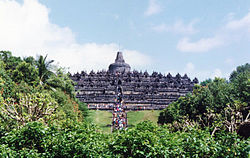
Back Sunda Vivitan Azerbaijani Sunda Wiwitan BAN सुन्दा विवितान Hindi Sunda wiwitan Croatian Sunda Wiwitan ID Sundha Wiwitan JV Sunda Wiwitan Malay Agama Sunda Wiwitan Sundanese 古巽他族信仰 Chinese
| Part of a series on |
| Religion of Java |
|---|
 |
| |
|---|---|
| ᮞᮥᮔ᮪ᮓᮝᮤᮝᮤᮒᮔ᮪ Sunda Wiwitan | |
 Seren Taun, the spiritual Sundanism harvest celebration. | |
| Type | Folk/ethnic religion |
| Scripture | Sanghyang Siksa Kandang Karesian |
| Governance | National Sunda Wiwitan Religious Council of the Republic Indonesia |
| Region | Worldwide, with origin in western hemisphere of Java (mainly Banten and West Java) |
| Language | Old Sundanese (used in rituals) and another Sundaic (Baduy and Sundanese) |
| Headquarters | Western Java (Banten and West Java) |
| Recognition | Officially recognized as one of the folk religions in Indonesia |
| Logo |  |
Sunda Wiwitan (also known as Sundanism, Sundaism, or Sunda folk religion) is an umbrella term referring to the native Western Javan folk or ethnic religion, traditionally adhered by the main Sunda ethnics (the Sundanese and Baduy), invented and originally practiced in the western hemisphere regions of the Indonesian island of Java.[1]
The followers of this belief system can be found in some villages in western Java, such as Kanekes, Lebak, Banten; Ciptagelar Kasepuhan Banten Kidul, Cisolok, Sukabumi; Kampung Naga; and Cigugur, Kuningan Regency. In Carita Parahyangan this faith is called Jatisunda. Its practitioners assert that Sunda Wiwitan has been part of their way of life since ancient times, before the arrival of Hinduism and Islam.
The sacred book of Sunda Wiwitan is called Sanghyang Siksa Kandang Karesian. It is a didactic text of religious and moral guidance, rules, and lessons. The text is identified as Kropak 630 by the National Library of Indonesia. According to the kokolot (elder) of Cikeusik village, the people of Kanekes are not adherents to Hindu or Buddhist faiths; they follow an animistic system of belief that venerates and worships the spirits of ancestors. However, over the course of time, Sunda Wiwitan has been influenced by and incorporated Hindu and, to some extent, Islamic elements.[2]
© MMXXIII Rich X Search. We shall prevail. All rights reserved. Rich X Search